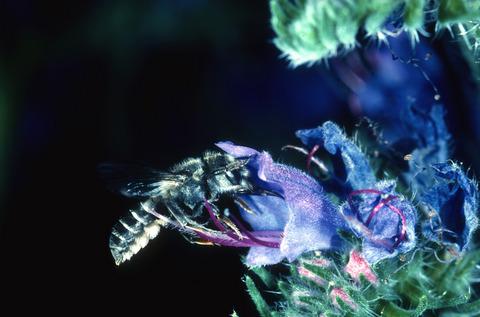当前位置:
X-MOL 学术
›
Funct. Ecol.
›
论文详情
Our official English website, www.x-mol.net, welcomes your feedback! (Note: you will need to create a separate account there.)
To bee or not to bee: The ‘raison d'être’ of toxic secondary compounds in the pollen of Boraginaceae
Functional Ecology ( IF 5.2 ) Pub Date : 2020-06-01 , DOI: 10.1111/1365-2435.13581 Vincent Trunz 1 , Matteo A. Lucchetti 1, 2 , Dimitri Bénon 1 , Achik Dorchin 3 , Gaylord A. Desurmont 4 , Christina Kast 2 , Sergio Rasmann 1 , Gaétan Glauser 5 , Christophe J. Praz 1
中文翻译:

养蜂还是不养蜂:蔷薇科植物花粉中有毒次级化合物的“存在理由”
更新日期:2020-06-01
Functional Ecology ( IF 5.2 ) Pub Date : 2020-06-01 , DOI: 10.1111/1365-2435.13581 Vincent Trunz 1 , Matteo A. Lucchetti 1, 2 , Dimitri Bénon 1 , Achik Dorchin 3 , Gaylord A. Desurmont 4 , Christina Kast 2 , Sergio Rasmann 1 , Gaétan Glauser 5 , Christophe J. Praz 1
Affiliation

|
- While the presence of secondary compounds in floral nectar has received considerable attention, much less is known about the ecological significance and evolutionary origin of secondary ‘toxic’ compounds in pollen. It is unclear whether the presence of these compounds in pollen is non‐adaptive and due to physiological ‘spillover’ from other floral tissues, or whether these compounds serve an adaptive function related to plant–pollinator interactions, such as protection of pollen against pollen thieves.
- Combining an experimental approach with phylogenetic comparative methods, and using western Palaearctic Boraginaceae as a model system, we investigate how pollen secondary metabolites influence, and are influenced by, relationships with bees, the main functional group of pollen‐foraging pollinators.
- We found a significant relationship between the levels of secondary compounds in the corollas and those in the pollen in the investigated species of Boraginaceae, suggesting that baseline levels of pollen secondary compounds may partly be due to spillover from floral tissues. At realistic levels, pollen secondary compounds showed significant detrimental effects on bee pre‐imaginal development, in agreement with previous egg‐transfer experiments showing that in some cases Boraginaceae pollen did not support pre‐imaginal development in bees not specialized on these plants.
- We also show that phylogenetically independent Boraginaceae taxa rewarding pollinators with pollen in addition to nectar exhibit significantly lower levels of toxic compounds in the pollen than taxa where the main reward is postulated to be nectar. Lastly, in contrast to our predictions, there was no positive association between toxin levels in the pollen of a given plant taxon and the number of bee species specialized on this taxon.
- We integrate all these findings and formulate an evolutionary scenario to account for the presence of toxic compounds in the pollen of Boraginaceae. We suggest that baseline levels of toxic compounds may be found in pollen due to spillover from other floral tissues and not primarily because of bee–flower interactions. Since pollen toxins can have detrimental effects on bees, we propose that selection acts to lower pollen toxin levels in plants where pollen, in addition to nectar, serves as a reward to bees.
中文翻译:

养蜂还是不养蜂:蔷薇科植物花粉中有毒次级化合物的“存在理由”
- 尽管花蜜中次生化合物的存在引起了广泛关注,但对花粉中次生“有毒”化合物的生态意义和进化起源的了解却很少。目前尚不清楚这些化合物是否在花粉中不具有适应性,并且是由于其他花卉组织的生理“溢出”,还是这些化合物是否具有与植物-授粉媒介相互作用有关的适应性功能,例如保护花粉免受花粉小偷的侵害。 。
- 将实验方法与系统发育比较方法相结合,并使用西部古北朝鲜蓟科植物作为模型系统,我们研究了花粉次生代谢产物如何影响蜜蜂并受其与花粉觅食传粉媒介的主要功能群的关系。
- 我们在所调查的蔷薇科物种中发现花冠中的次要化合物水平与花粉中的次要化合物之间存在显着的关系,这表明花粉次要化合物的基线水平可能部分是由于从花卉组织中溢出。在现实水平上,花粉次生化合物对蜜蜂的想象前发育显示出显着的有害影响,这与先前的卵转移实验一致,后者表明在某些情况下,蔷薇科植物的花粉不支持未专门种植于这些植物上的蜜蜂的想象前发育。
- 我们还显示,除了花蜜以外,花粉在系统发生学上独立的紫草科花粉对花粉传粉者的奖励比假定主要花蜜是花粉类的花粉具有更低的有毒化合物水平。最后,与我们的预测相反,给定植物分类单元的花粉中的毒素水平与专门针对该分类单元的蜂种数量之间没有正相关。
- 我们整合了所有这些发现,并制定了一种进化方案,以解释紫草科花粉中有毒化合物的存在。我们建议在花粉中发现有毒化合物的基线水平是由于从其他花卉组织溢出而引起的,而不是主要是由于蜂花相互作用。由于花粉毒素可能对蜜蜂产生有害影响,因此我们建议选择可降低植物中的花粉毒素水平,在这种植物中,除花蜜外,花粉还可以作为蜜蜂的奖励。



























 京公网安备 11010802027423号
京公网安备 11010802027423号